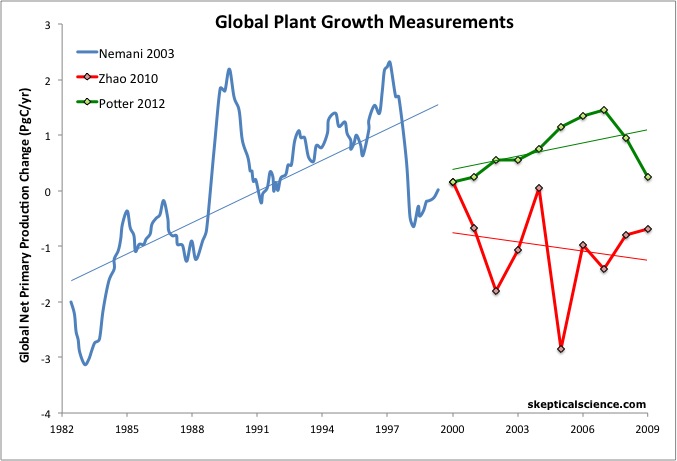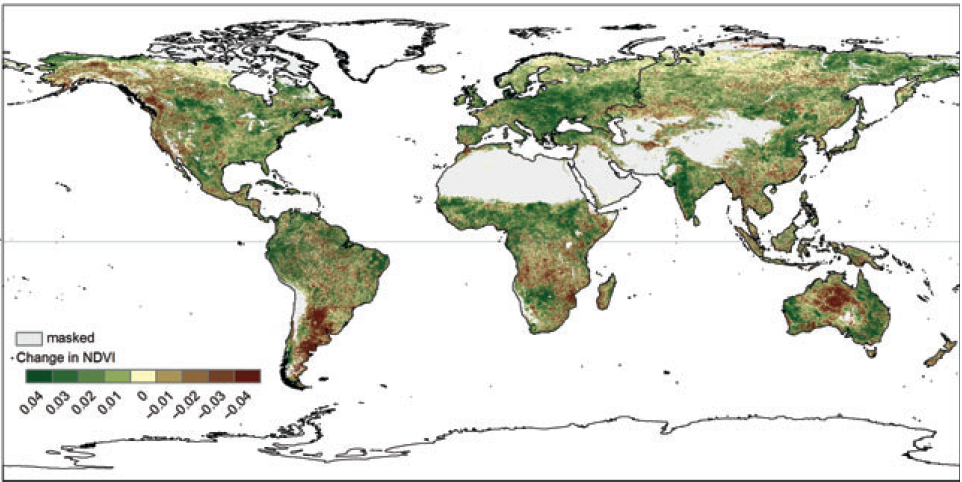Ridley, Murdoch, and Lomborg Attempt to Greenwash Global Warming
Posted on 16 January 2013 by dana1981
Matt Ridley is a businessman, chairman of a failed bank, and science writer who frequently publishes climate contrarian articles in the mainstream media (e.g. see here and here and here for our previous debunkings of his writings). His latest foray is an article in the Wall Street Journal, which has a long record of publishing nonsense from climate contrarians (e.g. see here and here and here).
This time around, Ridley's article is factually accurate. Really there's not much to it - Ridley simply discusses data showing that the planet has become 'greener' over the past few decades as vegetation has increased globally, on average. You might ask, "so what?". After all, we're not very concerned about current temperatures and climate change; we're concerned about the global warming yet to come and associated impacts on the climate, including more extreme weather, ocean acidification, sea level rise, species extinctions, etc.
If plant growth continues to increase, that could be one positive outcome of global warming (depending on what types of plant life thrive), but does the scientific research indicate this will happen? Unfortunately, Ridley leaves this critical question unanswered, and thus his audience might assume that the correlation between warming and increased vegetation will continue. Indeed, that appears to be Rupert Murdoch's conclusion from Ridley's article. On the contrary, as we will see below, continued reliance on fossil fuels will make conditions difficult for global vegetation, and for the rest of the world's ecosystems.
"Greening" Research is a Mixed Bag
Net Primary Production (NPP) is essentially a measurement of plant growth. Figure 1 shows the results from three studies which sought to measure changes in NPP.
Figure 1: Net primary production change measurements (in petagrams [1015 grams] of carbon per year) from Nemani et al. 2003 (blue), Zhao and Running 2010 (red), and Potter et al. 2012 (green).
As you can see, according to Nemani et al. 2003, global plant growth rose from the early 1980s to the late 1990s. Zhao and Running 2010 picked up where Nemani left off, and found that this trend had not continued into the 21st century. According to their estimates, global plant growth had declined, or at the very least the increase had slowed. Potter et al. 2012 examined the data and did find an increasing trend from 2000 to 2009, but at a slower rate than the prior two decades.
The Potter results are also consistent with the research that Ridley references in his article (de Jong et al. 2012). Rather than examining net primary production, de Jong et al. uses the Normalized Difference Vegetation Index (NDVI), which measures plant growth by using satellites to look at the near-infrared part of the light spectrum, where healthy vegetation is very reflective. Their results showing the net change in NDVI from 1982 to 2008 are illustrated in Figure 2, with green representing a greening, and brown representing a browning.
Figure 2: Global greening and browning in terms of normalized difference vegetation index changes between 1982 and 2008, from de Jong et al. 2012
The de Jong research finds less overall greening in the southern hemisphere (SH) than the northern hemisphere (NH), which is similar to the Zhao and Potter results, both of which find a decrease in SH plant growth from 2000 to 2009. Zhao and Running connect this decline to an increase in drought activity.
"Over the past 10 years, large-scale periodic regional droughts and a general drying trend over the SH reduced global terrestrial NPP. Under a changing climate, severe regional droughts have become more frequent, a trend expected to continue for the foreseeable future"
They find a very strong correlation between droughts in the southern hemisphere and decreased plant growth. This is also consistent with the results of Choat et al. 2012, who find that forests worldwide are becoming increasingly vulnerable to drought.
"We show that 70% of 226 forest species from 81 sites worldwide operate with narrow hydraulic safety margins against injurious levels of drought stress and therefore potentially face long-term reductions in productivity and survival if temperature and aridity increase as predicted for many regions across the globe....These findings provide insight into why drought-induced forest decline is occurring not only in arid regions but also in wet forests not normally considered at drought risk."
Plants Need More than CO2 to Grow
Ultimately Ridley and Murdoch's comments harken back to the oversimplified argument that CO2 is plant food. Bjorn Lomborg joined this party in an article published by Slate, arguing that CO2 fertilization will increase wheat crop yields.
It's true that when all else is held relatively constant, for example in a greenhouse, adding CO2 to the environment tends to increase plant growth. However, when we add more CO2 to the atmosphere, it changes the climate. More extreme weather results, like heat waves, bush fires, droughts, and floods - conditions which are obviously not favorable to plant growth. And as John Mason recently noted,
"A key constraint of the carbon fertilization effect on the ground (and not in the controlled conditions of a greenhouse or laboratory) is that it would be operating in situations where other variables, essential to plant growth, may not play ball. It's a long list when one includes all the various minerals and trace-elements but key factors are major nutrients such as phosphorus, potassium, nitrogen and so on. CO2 is plant-food but so are these elements and they are essential, as any serious vegetable-grower will tell you."
A new paper in press, Hawkins et al. (2012) examined maize yields in France and found that improved agricultural technology has increased crop yields, but hotter temperatures are taking a toll, and the increase has begun to slow (Figure 3).
"A significant reduction in maize yield is found for each day with a maximum temperature above 32°C, in broad agreement with previous estimates. The recent increase in such hot days has likely contributed to the observed yield stagnation....We conclude that, to offset the projected increased daily maximum temperatures over France, improved technology will need to increase base level yields by 12% to be confident about maintaining current levels of yield for the period 2016-2035; the current rate of yield technology increase is not sufficient to meet this target."
Figure 3: French maize yields from FAOSTAT (black points) and empirical model predictions for the technology trend (grey shading) and expected yield (red shading) with total uncertainties (red lines), considering both temperature and precipitation. The black error bar indicates the forecast for 2011, assuming a flat technology trend since 2010. For the 2016-2035 periods, the boxes show the 25th-75th percentiles and the whiskers indicate the 5th and 95th percentiles. The yield projections assume a flat technology trend and are shown for both climatological precipitation (left) and precipitation constrained by historical correlations between temperature and precipitation (right).
In particular, note the low maize yield in 2003, associated with the major heat wave that summer. The projections for 2016—2035 in blue and red demonstrate that climate change is anticipated to decrease crop yields unless technological improvements can offset the effects of increased heat. Hawkins has also noted that technological improvements have played a much larger role than CO2 fertilization in increasing yields in crops like maize.
Gornall et al. (2010) also examined how climate change will impact agricultural production in the near future, and found that we cannot yet answer the question - it is more complex than Lomborg suggests.
"Perhaps most seriously, there is high uncertainty in the extent to which the direct effects of CO2 rise on plant physiology will interact with climate change in affecting productivity. At present, the aggregate impacts of climate change on global-scale agricultural productivity cannot be reliably quantified."
For those who want more gory details about why 'CO2 is plant food' is a gross oversimplification, we've got you covered. And we'll have a more detailed post about CO2 plant fertilization research in the near future.
Burning Fossil Fuels Has Many Negative Consequences
Rupert Murdoch also asked why we don't "switch from useless renewable energy investments". The answer is that continuing to rely on fossil fuels will increase the incidence of heat waves (which Australians are currently experiencing at record levels), ocean acidification, expansion of the subtropical dry zones, exacerbated flooding and drought, mass coral bleaching, the decline of the Great Barrier Reef, further sea level rise, wide-scale species extinctions, etc. The overall consequences of continuing to rely on fossil fuels will be very bad, regardless of how plant productivity changes.
Greenwashing a Harsh Reality
Ridley, Murdoch, and Lomborg attempt to gloss over this harsh reality by focusing on one consequence of global warming which has so far been a positive one. Ridley has developed a reputation for this sort of unfounded optimism, always assuming the best case scenario, never preparing for the worst. This appears to be his approach when it comes to the impact of climate change on plant growth as well. He only looks at the data which paints a rosy (or in this case, green) picture, and ignores the rest.
This leaves people like Rupert Murdoch, who desperately want human-caused climate change to be a non-issue and to maintain the status-quo, to assume that the greening trend and increase in crop yields over the past few decades will continue. In reality, this trend may already be reversing, and the impacts of climate change like droughts and heat waves will not bode well for plant growth in the future. This greenwashed view also ignores the many other negative impacts of climate change, from ocean acidification to sea level rise to species extinctions.
CO2 may be plant food, but irrational optimism is not. If we want plant life to continue thriving, we have to do better than ignoring inconvenient science; we have to take steps to stop human-caused climate change and its harsh impacts.































 Arguments
Arguments

































A useful reference on this question is a book by Richard Preston: DRIVEN TO EXTINCTION: The Impact of Climate Change on Biodiversity. He discusses animals more than plants, but on pp 175-179 he decribes the work of Blake Suttle, an ecologist who set up experimental plots in the Angelo Coast Range Reserve of California's Mendocino county.
Suttle's aim was to measure the impact of increased rainfall on local biodiversity. He found it increased for the first two years, as expected. But then it declined, and by the fifth year there was only half the original number of species. Grasses had crowded many other species out, and as a result the nutritional value per square foot dropped sharply.